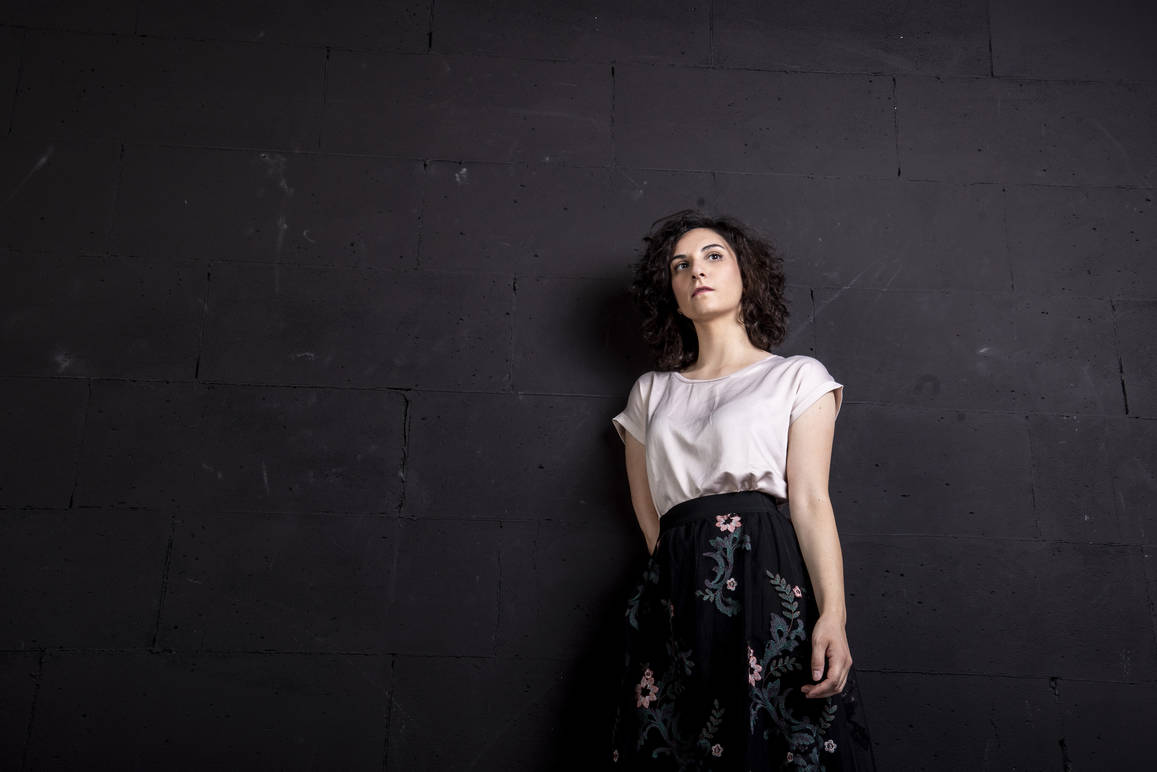“No Name”: Sicilian Singer Francesca Incudine Evokes the Memory of the Triangle Fire
I first came across Francesca Incudine’s song last year while researching contemporary literary and artistic representations of the Triangle fire for the course on that subject I teach at New Jersey City University and the book I have recently completed with Mary Anne Trasciatti, an anthology of intimate and political essays on the Triangle fire, Talking to the Girls. In my classes, I prod my students to look for visceral connections with the 1911 fire. In the book, Mary Anne and I pushed our nineteen contributors to tell their Triangle stories. We asked them to weave the intimate and the political by exploring what generated and sustained their interest in the fire, what preceded it—especially the Uprising of the 20,000, the famous 1909 strike of shirtwaist workers—and its aftermath—the many important social and legal changes that recognized that safety in the workplace is a human right. When I first listened to Francesca’s song, I felt the pull of the personal in her haunting, historically compelling lyrics, in her voice that beautifully weaves the jarring poetry of Sicilian and Italian, in the words that meet and mingle—a linguistic hybridity so familiar to me. I felt that pull in the song’s evocative video with its multiple images from the fire that serve as a canvas upon which the singer, wearing a shirtwaist, is superimposed. I also felt the pull to learn more about Francesca Incudine, this fellow Sicilian so compelled to sing for the Triangle workers.
How did you learn about the fire of the Triangle Waist Company and when and how did you come up with the idea of writing a song inspired by the fire?
I have always felt drawn to the idea of telling stories. I am a songwriter, and so, in addition to singing, I must tell stories. I love to go on long walks and to go inside bookstores to lose myself among the books. Ester’s book [Rizzo Licata] had just come out and was there, on a small stand to the side. The book called me. I knew a little about the story, although in a very confused way, since it was believed that the fire occurred on March 8, International Women’s day, while in reality it happened on March 25. Immediately, I liked the cover. I read the book without stopping that same night. After, I started dreaming of all these women. I tried to imagine their voices. For an entire week, those nameless faces, their stories, called me. They needed to be spoken. And so, after a week of haunting dreams, of thinking about their vicissitudes, about their own dreams reduced to ashes, the song was born—inspired by Ester’s work. As soon as I wrote the song, I felt the need to connect with the woman who had done this work on behalf of other women—I wanted to feel part of this sisterhood of names and memories that Ester has been working on for a long time. That moment became a perfect union of reality, music, and story. I am very grateful for such encounters. I believe they are not accidental—just like ours. These women needed for someone to tell their stories. I offered my services to give them voice through my song.
There is something sacred in your song. Can you speak of the process of writing it?
I love to link words, sounds, and images. In this sense I feel, as I say often, a little Baudelairean. Sounds turn into images and poetry. I sought to put together the images from the book with those recurring dreams I had the week after I read the book. I tried to create from that experience a text that would speak through images. The text was born first. After that, the music, in collaboration with my musicians. Even in that case, the sound had to become word. For this reason, in the song you hear a sound that is reminiscent of knitting needles, sewing machines, chaos, industrial sounds, in contrast with the poetic quality of the lyrics, especially when I go from Italian to Sicilian—because I was clearly struck by the fact that this is a story of Sicilian women. Many of them were Sicilian—one in particular, Giuseppina Cammarata, was from the province of Enna, my hometown. The idea of researching, through images and sounds, a fellow countrywoman, my own neighbor, shook me up. I tried to infuse all of this in the composition, in the words, and in the music. Once created, the text was polished, revised, and naturally the raw material took the form of the song that you have heard.
Can you talk about the use of Sicilian in your songs and the mixing of Sicilian and Italian?
Since the beginning, I felt the need to sing in my mother language, even as in time I added Italian to provide a frame of reference to clarify the text [for audiences that do not know Sicilian], without forcing [a translation], however, because Sicilian is such a musical language with many words that are untranslatable, as is the case for other dialects and languages. I always say that it’s important that there is always a message of truth in the language in which one chooses to sing, whichever language that may be. For an artist, it’s important to express themselves in the language in which they recognize themselves. And it is important for those who listen to be ready to overcome prejudice, the fear of the unknown.
I felt so powerfully the need to make those women speak in Sicilian, especially in the storytelling, and in the references to the departure from their land. In fact, the passage from Italian to Sicilian in the song occurs exactly in the moment of the flashback, the memory of the crossing. It seemed right to pay homage to this land that, for these women, was so bitter and so beautiful, a land they had to leave to pursue a dream that vanished in ashes.
Why the title “No Name”?
What struck me the most was the image of these bodies, the seams of those skirts, those shoes without heels, those faces without names. Names identify us. We need to hear our names called to feel recognized. I felt the need to recognize these women who had been absent from history, to restore their memory and, through music, even their dignity. They were not just factory workers: they were Giuseppina, Maria. They had their own stories, their dreams, a mother, a father, a fiancé. A name contains a story.
The text of “No Name” is very precise from a historical point of view. For example, you use the actual name of the factory, Triangle Waist Company, instead of the name typically used, Triangle Shirtwaist Factory; you give the name of the building, Asch; you mention the notorious ninth floor, which, among the three floors of the factory, was the one that had the largest number of victims; you sing of the locked doors. Why has paying attention to historical details been so important for you?
I believe it was necessary to contextualize and to speak of historical facts as a reporter would. I became songwriter and reporter at once because reporting provides that sharp, at times chilling vision that forces you to listen. “146 of us burned in March.” It stops you in your tracks and takes you from poetry back to reality in one instant. It is important to say that these things happened in a certain period, in a certain place, especially when music reaches the new generations. Many kids listened to my music and fell in love with “No Name.” Through “No Name,” they learned this story. It was important that the story be accurate—and here Ester’s careful work obviously helped. Then, I added my baggage. I went in search of images, then pieced them together in a fragmentary manner in the video, where archival images are juxtaposed to images of me. The past is superimposed over the present and also the future so that things like this [fire] never happen again.
The video is extraordinary, so evocative, with that image of you wearing a shirtwaist, and the sea that has so many layers of meaning. What role did you have in the choice of the images for the video?
I came up with the ideas with videomaker Emanuele Torre, who fully agreed that we should stratify the images in such a way that I, too, become story. He also agreed about including the evocative presence of the sea. Although I come from a town where there’s no sea, I always evoke the sea in my songs. I feel this desire for expansiveness, to let my thoughts sail away. I believe that the image of the sea in the video is fundamental because it was the means by which the story came to be and still speaks to us today.
The fact that fire happened on a Saturday is often discussed because, being Jewish, many of the workers should have been home for the Sabbath. What is rarely if ever discussed is the fact that March 25 is the Day of the Annunciation. Why did you include this detail in your song?
I am glad you noticed this detail. The Annunciation is a significant detail that I did want to include. Obviously, the Annunciation has its own religious meaning. But it’s also an omen, in this case of death rather than life. The choice to contrast the life that is being announced and the death the girls would soon find was deliberate.
In the 1970s, a song by the Movimento Femminista Romano. “8 marzo,” spoke of workers who had died in a factory. We knew the song referred to a factory in New York City, but we didn’t know the details, and we didn’t know that many of the workers who died were Italian, primarily Sicilian. Through your song, you created many connections but also filled historical gaps. Do you think that this story that has been for decades part of the Italian feminist consciousness, although in vague details, now it’s better known in Italy thanks to your song, Marco Savatteri’s musical, Ester Rizzo’s book and the beautiful initiative of Toponomastica Femminile? Or do you believe that the story remains little known or is not yet recognized as a key chapter in the history of Italian emigration?
I believe that the confusion between the two dates still exists, that the historical inaccuracy you refer to persists. What especially persists is the cultural falsehood of a day that celebrates women—it’s a celebration but there is little to celebrate. There’s a lot to remember. There is a cultural disconnect. [Since] It is we, the women, who are speaking about ourselves, we must reclaim those missing pieces. For me, it was essential to clarify, to set the record straight, in the story of the fire, in my art, in my story, in the way I communicate. We must recover a historical and cultural awareness in order to communicate and pass on [the legacy]. Music cannot be an end in itself, at least the way I live it. 360 degrees. There must a be close bond between how I live, what I sing, and what I believe.
Are you planning to write other songs that deal with forgotten stories such as that of the Triangle fire?
I am working on a project titled Voices Outside the Wall that includes a series of songs linked through the symbol of a wall that rises as a barrier but also becomes transparent. The second song, which will be out in April, tells the story of Sabeen Mahmud, a Pakistani activist who was shot to death because she fought for human rights. I learned about her thanks to the Italian consul who invited me to Pakistan. This song, too, came as a dream after I read her book as well as testimonials and watched videos.
Iettavuci is a sort of artistic manifesto. Is “No Name” a kind of “iettari vuci” [literally throw voices, speak out]?
Exactly. Iettavuci was my first project. The projects that followed had in common a need, which at first was personal, to express, to be heard, but also to give voice to those who have lost it, or whose voice is broken, or to those who are vulnerable or afraid to say what they think—and we must find an audience that will listen. We need dialogue, conversations. Without them, we are, as Bufalino said, islands inside islands that will never meet anyone.
----
Edvige Giunta is the author of Writing with an Accent: Contemporary Italian American Women Authors and coeditor of five anthologies, including The Milk of Almonds: Italian American Women Writers on Food and Culture, Embroidered Stories: Interpreting Women’s Domestic Needlework from the Italian Diaspora, and Personal Effects: Essays on Memoir, Teaching, and Culture in the Work of Louise DeSalvo.
At New Jersey City University, where she is Professor of English, she has trained scores of students in the art of memoir and created the first course devoted exclusively to the Triangle fire. Her literary nonfiction and poetry appear in many journals and anthologies. She has been profiled in The New York Times and RAI For her work on memoir and Italian American studies. Her book Talking to the Girls: Intimate and Political Essays on the Triangle Fire, coedited with Mary Anne Trasciatti, will be published in 2022 by New Village Press.









































Comments
1
1
1
1